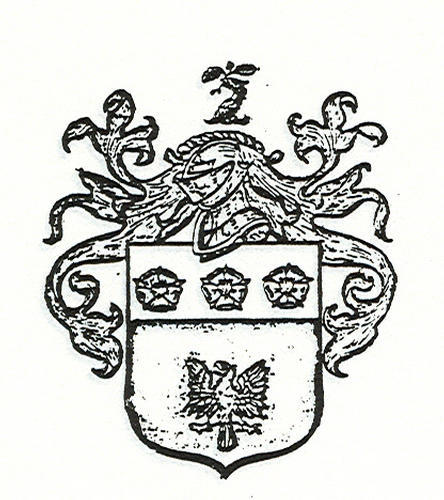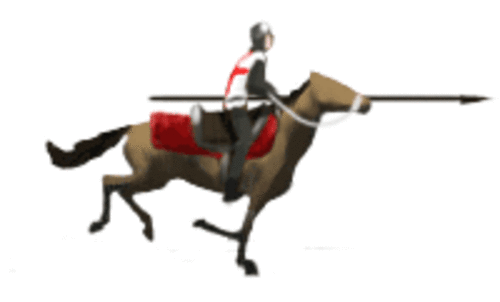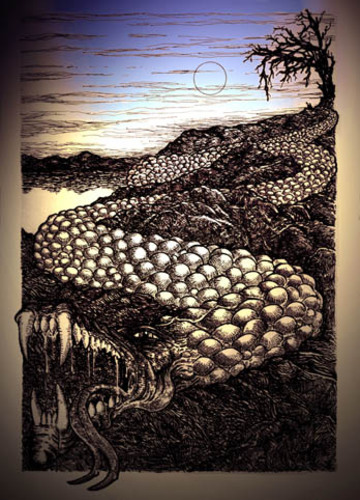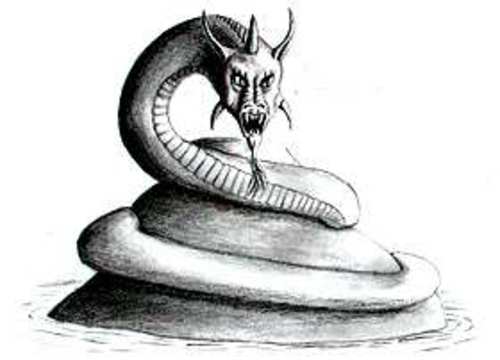Linton Dragon Slayer
Welcome to the LINTON Chronicles
Linton Dragon
Terry Louis Linton © 1984 LINTON Chronicles
Linton Research Fund Inc., Publication © 2011
LINTON Chronicles Volume X, Issue 2, Summer © 2011, ISSN 1941-3521
2024 markes the 850th anniversary of the Slaying of the Linton Dragon
My 26th great-grandfather, John Somerville (1150-1194) of Carnwath, Lanarshire, Scotland, in 1174, encountered the Linton Dragon, also known as the Wyrm of Wormistone, of Parish Lintone. To defeat it Somerville took a long spear to which he fixed a divot of peat dipped into a mixture of boimling pitch, resin and brimstone." " The wode Laird of Lariestoun Slew the wode worm of Wormiestoune, and wan all Lintoan paroschine." " And further to perpetuate this actione, the barons of Lintoun, Cowthally, and Drum, did always carry for crest, a wheel, and thereon a dragoun."
Extracted from a genealogical MS. in the Advocates' Library, written about I68O. The falcon on the champion's arm, in the monument, may be supposed to allude to his office of falconer to William of Scotland.
Linton Research Fund Inc., Publication � 1987-2024 "Digging for our Roots"

Linton Dragon
Terry L. Linton © 1975
LINTON & BIRD Chronicles Volume I, Issue 4, © Winter 1984-1985
Linton Research Fund Inc. Publication © 2011
LINTON & BIRD Chronicles, Volume VI, Issue 1, Spring © 2011, ISSN 1941-3521
_______________________
While doing the requirements to be certified by the National Association of Certified Genealogists, I ran across the leather bound book Minstrelsy of the Scottish Border, Vol. III by Sir Walter SCOTT (1771-1832) in the Library of Congress. I spent well over a full year researching and hand coping this 1802 master piece. Sir Walter Scott, 1st Baronet was born on August 15, 1771 and died on September 21, 1832. Walter was an Scottish historical novelist, playwright, and poet, popular throughout much of the world during his time. Sir Walter Scott soured his research from The Memorie of the Somervilles written by Baron James Somerville in 1679 and the oral traditions of his family stories handed down to him.
Minstrelsy of the Scottish Border, Vol. III
Consisting Of Historical And Romantic Ballads, Collected In The Southern Counties Of Scotland; With A Few Of Modern Date, Founded Upon Local Tradition Author: Walter Scott, In Three Volumes. VOL. III.
Printed by James Ballantyne and Co. Edinburgh
Fifth Edition.
Printed for Longman, Hurst, Rees, Orme, and Brown,
London ; and A, Constable and Co. Edinburgh. 1821.
�
Minstrelsy of the Scottish Border, Vol. III
Excerpted from Pages 21 through 25
Linton Dragon
Above the south entrance of the ancient parish church
of Linton, in Roxburghshire, is a rude piece of sculpture,
representing a knight, with a falcon on his arm, encountei'ing
with his lance, in full career, a sort of monster,
which the common people call a norm, or snake. Tradition
bears, that this animal inhabited a den, or hollow,
at some distance from the church, whence it was wont
to issue forth, and ravage the country, or, by the fascination
of its eyes and breath, draw its prey into its jaws.
Large rewards were in vain offered for the destruction
of this monster, which had grown to so huge a bulk, that
it used to twist itself, in spiral folds, round a green hillock
of considerable height, still called Wormeston, and
marked by a clump of trees. When sleeping in this place,
with its mouth open, popular credulity affirms, that it
was slain by the Laird of Lariston, a man brave even to
madness, who, coming upon the snake at full gallop,
tluust down its throat a peat (a piece of turf dried for
fuel,) dipt in scalding pitch, and fixed to the point of his
lance. The aromatic quality of the peat is said to have
preserved the champion from the effects of the monster's
poisonous breath, while, at the same time, it clogged its
jaws. In dying, the serpent contracted its folds with so
much violence, that their spiral impression is still discernible
round the hillock Avhere it lay. The noble family
of Somerville are said to be descended from this
adventurous knight, in memory of whose achievement
they bear a dragon as their crest.
The sculpture itself gives no countenance to this fine
story ; for the animal, whom the knight appears to be in
the act of slaying, has no resemblance to a serpent, but
rather to a wolf, or boar, with which the neighbouring
Cheviot mountains must in early times have abounded;*
and there remain vestiges of another monster, of the
same species, attacking the horse of the champion. An
inscription, which might have thrown light upon this
exploit, is now totally defaced. The vulgar, adapting
it to their own tradition, tell us that it ran thus :
The wode Laird of Lariestoun
Slew the wode worm of Wormiestoune,
And wan all Lintoan paroschine.
It is most probable, that the animal destroyed by the
ancestor of Lord Somerville, was one of those beasts of
prey by which Caledonia was formerly infested, but
which, now.
Razed out of all her woods, as trophies hung,
Grin high emblazon'd on her children's shields.
________________________
In further research I came across more from Author Sir Walter Scott
Walter Scott, Since publishing the first edition (1806) of this work I have found the following account of Somerville's achievement, in a INlS. of some antiquity
John Somerville (son to Roger de Somerville, baron
of Wychnor, in Staffordshire) was made, by King
William (the lion,) his principal falconer, and got
from that King the lands and baronie of Linton, in Tiviotdalcj
for an extraordinarie and valiant action; which,
according to the manuscript of the family of Drum,
was thus: In the parochen of Lintoun, within the sheriffdom
of Roxburgh, there happened to breed a monster,
in form of a serpent or worme ; in length, three
Scots yards, and somewhat bigger than an ordinarie
man's leg, with a head more proportionable to its
length than greatness. It had its den in a hollow piece
of ground, a mile south-east from Lintoun church ; it
destroyed both men and beasts that came in its way.
Several attempts were made to destroy it, by shooting of
arrows, and throwing of darts, none daring to approach
" so near as to make use of a sword or lance. John Somerville
undertakes to kill it, and being well mounted,
" and attended with a stoute servant, he cam, before
" the sun-rising, before the dragon's den, having pre-
" pared some long, small, and hard peats (bog-turf dried
" for fuel,) bedabbed with pitch, rosett, and brimstone,
" fixed with a small wyre upon awheel, at the point of his
" lance : these, being touched with fire, would instantly
" break out into flames ; and, there being a breath of
" air, that served to his purpose, about the sun-rising,
" the serpent, dragon, or worme, so called by tradition,
" appeared with her head, and some part of her body.
" without the den ; whereupon his servant set fire to the
" peats upon the wheel, at the top of the lance, and
'* John Somerville, advancing with a full gallop, thrust
" the same with the wheel, and a great part of the lance,
" directly into the serpent's mouth, which wente down
" its throat into the belly, and was left there, the lance
" breaking by the rebounding of the horse, and giving
*' a deadly wound to the dragoun ; for which action he
" was knighted by King William ; and his effigies was
" cut in ston in the posture he performed this actione,
" and placed above the principal church door of Lintoun,
" where it is yet to be seen, with his name and
" sirname : and the place, where this monster was kill-
" ed, is at this day called, by the common people, who
" have the foresaid story by tradition, the Wormes Glen.
" And further to perpetuate this actione, the barons of
" Lintoun, Cowthally, and Drum, did always carry for
" crest, a wheel, and thereon a dragoun."—Extracted
from a genealogical MS. in the Advocates' Library,
written about I68O. The falcon on the champion's arm,
in the monument, may be supposed to allude to his office
of falconer to William of Scotland.
*******************************************************************
�We exist because of our ancestors, let�s try not to forget them�
In the Border Minstrelsy we read that—
The wode Laird of Larcestoun
Slew the wode worm of Wormestoun.
And wan all Linton paraschine.
Linton, like Lyndhurst, comes from lind, a fiery serpent, and it is probably from lind that we get our word blind-worm. It is still the custom when the new bishop enters the diocese of Sockburn, for the lord of that domain to meet him in the middle of the river Tees and present him with an ancient sword, saying, 'My Lord Bishop, I here present- you with the faulchion wherewith the Champion of Conyer slew the worm, dragon, or fiery flying serpent which destroyed man, woman, and child, in memory of which the King then reigning gave him the manor of Sockburn to hold by this tenure, that upon the first entrance of every Bishop into the country the faulchion should be presented.' There is wrapped in this legend, probably, the fact that one Conyers afforded Bishop Flambard a safe retreat from the Scottish invader Comyn, whom he afterwards brought to kneel at the Bishop's feet.
The most interesting of all these worms, however, is that of Lambton. The visitor to that region, near Neweastle, may still discover a trace of the wonderful well into which the little worm was thrown, and the hill is still pointed out around which he coiled nine times when he emerged as a monster. The story runs, that the young Knight of Lambton employed all Sunday fishing in the Weir, to the
great scandal of church-goers. On* he caught a small worm, which he threw into a well. There it sweliri to vast dimensions. The yooiie knight, however, went off to th a holy wars in Palestine. When h returned he found the neighborhood in great trouble. The master lay on his hill, demanded mm cows' milk daily, and if one cup ks were offered devastated the village in his wrath. Various knights hi attacked him vainly, for when cr in two the worm pieced himse. together again. The knight whee Sunday fishing had caused all lis trouble resolved to encounter t>. worm. He was told by an orseithat he would succeed if he am-himself with a coat of mail covers with razor-blades, and met the master in the river; but that after sfejing him he must sacrifice the firs living thing he met, or, if he did w. no Lambton would die in his bed fcnine generations. He did so. Ht enticed the worm into the rmr Weir; it coiled around the raws of his armour and was cut to pietw the pieces could not now join :> gether again, because the curre: bore them away. In the Rig TA (i. 32) we read this of Indra's Colflict with the dragon Vritra: 'The waters carry away the nameles body of Vritra, tossed into the miis of the never-stopping, never-resting currents.' Oar Lambton hero on coming from this victory me: first his own father. As he coul: not sacrifice him, the doom passed on the family, and everybody yee meet in that region will inform yp» that, strange to say, no Lambrw has ever since died in his bed—th e doom having ended with the la:~ Earl of Durham, who, they affirrL. died in his chair. No element rt' the solar myth is wanting here. The razors on the armour, as portrayed on the ancient statue at Lambton Castle, are raj-s of light. The growth of the monster from i small worm, is the twilight increas
ing to midnight. The worm piecing itself together again when cut in two, is the hydra-head growing out again after Hercules has cut it off; that is, so often as the sun dispels the night the night grows together again. The symbolism is equally preserved if the myth be referred to the swelling, dispersed, and recurring cloud. And thus we find the ancient Vritra, Python, Hydra, living on to reflect every evil as it comes in history—Paganism, as conquered by someancient saint,—miasma, as conquered by some enterprising drainer of swamps,—or at length sabbathbreaking, as illustrated for Northumbrian boys in the terrible story of the Lambton Worm.
_____________________
"The Dragon of Wyrmiston used to live on a hill nearby to Linton and plagued the surrounding area. Eventually, a local man called Somerville came up with a way of killing the creature. He placed a cart wheel on the end of his lance, covered it in pitch, and set fire to it. He them rammed the wheel down the throat of the dragon, killing it."
The Linton Wyrm
By Andrew L. Paciorek
Modern defination of Wyrms
Wyrms
Also known as: Serpents, Serpent-Dragons, Worms, Wermes, Wyrrms, Wurms, Orms, Askes, Stoorworms, Vurms, Carrogs, Paiste.
Despite being limbless and therefore less mobile than some other Demi-Dragon breeds, Wyrms were just as capable of causing great devastation and could also prove to be a perplexing quandary for potential slayers, as many had the ability to congeal their body parts together again should they be hacked apart - though a single slicing blow from a woodman’s axe was enough to end the suffering caused by the Great Worm of Shervage Wood in Somerset. The Linton Worm of the Scottish Borders was dispatched by a burning lance being thrust down its throat, whilst it took a razor-barbed suit of armour, a keen blade and the current of the River Wear to rid County Durham of the Lambton Worm. Occurring after Saint Patrick had supposedly banished all serpents from Ireland, Saint Murrough was said to have rid Derry of a colossal Wyrm known as the Lig-na-Baste (or Lig-na-Paiste) meaning the Last Great Reptile.
Below Illustration: The Linton Wyrm by � Andrew L. Paciorek
__________________________
THE TERRIFYING TALE OF THE LINTON WORM
By Martin Somerville (1796-1856)
1845 Montreal Gazette
LINTON & BIRD Chronicles Volume I, Issue 5, © Spring 1985
Reprint Linton Reseach Fund Inc., Publication © 2011
LINTON & BIRD Chronicles, Volume VI, Issue 1, Spring © 2011, ISSN 1941-3521
The ancient race of Somerville's played an important part in Linton's history and legend. The original Walter de Somerville came over from Normandy with William the Conqueror. A descendant, William was knighted by Bruce. Linton Tower was the family's stronghold for close on two and a half centuries, and their bones were buried in the chancel of the church.
The tale of how Somerville of Lariston slew the "Worm" of Linton and was rewarded with the Barony, is traditional in the Borders. During the 12th century the people of Linton were kept in a state of great distress because of a terrible monster or "Worm." (orme or worme is the ancient Norse for serpent) A 12th century writer described it as "In length three Scots yards and bigger than ordinary man's leg in form and callour to our common muir edders."
The monster lived in a hollow on the side of Linton Hill, a spot still known as the "Worm's Den." from its lair it crept all over the countryside and kept people in constant terror. Somerville of Lariston, having heard so many tales was determined to see the beast and work out a plan for its destruction.
He rode to its den at dawn, when the beast crawled out to find a horseman so near, "It lifted its head and half its body and for a long time stared him in the face with open mouth," after which it crept back into its den without doing him any harm.
Somerville hit on an ingenious plan to get rid of the beast, he noted that it invariably stared an observer the face with open mouth, so he had a long lance made of great strength with a wheel near the point which turned very easily. On the point of the lance he placed a lighted peat daubed with pitch. For many days he rehearsed his proposed attack, so that the horse would become used to the smoke blowing in its face.
Then in spite of many sceptics among his neighbors he set out for the "Worm's" den accompanied by a servant. Whenever the beasts head appeared the servant lit the peat, then spurring his horse to full gallop Somerville charged the monster and thrust his lance with the burning peat into its open mouth and down its throat. The fatal blow had been dealt, In the pangs of death the monster raised up the whole ground that was above her (part of her body being still in the den) and overturned the same to the furthering of her ruin.
For his heroic deed Somerville was appointed Royal Falconer, honoured with a Knighthood and made First Barrone of Linton. The crest of the Somerville's was wyvern (heraldic dragon) perched on a wheel. The peerage is now extinct.
_____________________________
Illustration by illustrator Martin Somerville (1796-1856) � 1845 Montreal Gazette The Linton Wyrm
Scottish LINTON Coat of Arms & Crest, pen & Ink illustration, by Terry Louis Linton, � 1977 All Rights Reserved Linton Research Fund Inc., Publication � 1987, Reproduction in whole or in part without written permission is prohibited.

Linton Research Fund Inc., Publication � 1987-2024 "Digging for our Roots"

“We exist because of our ancestors, let’s try not to forget them”
"That’s a beautiful and profound statement. Our ancestors’ experiences, struggles, and achievements have shaped the world we live in today. It’s important to honor and remember them, as they are a part of our history and identity”
Terry Louis Linton © 2012.
_____________________________________
Main Menu
Linton Research Fund, Inc., HOME PAGE
LINTON Chronicles Table of Contexts
LINTON Ancestors in the Revolutionary
LINTON Ancestors in the Civil War 1861-1865
BIRD Chronicles Table of Contents
Bird Ancestors in the Revolutionary War
BIRD Ancestors in the Civil War 1861-1865
Today's Birthdays & Anniversaries
History of the Linton Research Fund Inc., LINTON & BIRD Chronicles
LINTON & BIRD Chronicles on Facebook
![]() "Thanks for Visiting, come back when you can stay longer" Terry Louis Linton © 2007
"Thanks for Visiting, come back when you can stay longer" Terry Louis Linton © 2007
Linton Research Fund Inc., Publication © 1987-2024 “Digging for our roots”
LINTON & BIRD Chronicles
Established 1984
Quarterly Publication of the Linton Research Fund Inc. ![]()



